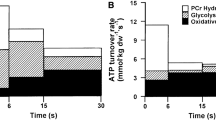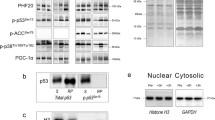Summary
This study was conducted to determine whether the pedaling frequency of cycling at a constant metabolic cost contributes to the pattern of fiber-type glycogen depletion. On 2 separate days, eight men cycled for 30 min at approximately 85% of individual aerobic capacity at pedaling frequencies of either 50 or 100 rev·min−1. Muscle biopsy samples (vastus lateralis) were taken immediately prior to and after exercise. Individual fibers were classified as type I (slow twitch), or type II (fast twitch), using a myosin adenosine triphosphatase stain, and their glycogen content immediately prior to and after exercise quantified via microphotometry of periodic acid-Schiff stain. The 30-min exercise bout resulted in a 46% decrease in the mean optical density (D) of type I fibers during the 50 rev·min−1 condition [0.52 (0.07) to 0.28 (0.04)D units; mean (SEM)] which was not different (P>0.05) from the 35% decrease during the 100 rev · min−1 condition [0.48 (0.04) to 0.31 (0.05)D units]. In contrast, the meanD in type II fibers decreased 49% during the 50 rev·min−1 condition [0.53 (0.06) to 0.27 (0.04) units]. This decrease was greater (P<0.05) than the 33% decrease observed in the 100 rev·min −1 condition [0.48 (0.04) to 0.32 (0.06) units). In conclusion, cycling at the same metabolic cost at 50 rather than 100 rev·min−1 results in greater type II fiber glycogen depletion. This is attributed to the increased muscle force required to meet the higher resistance per cycle at the lower pedal frequency. These data are consistent with the view that force development as opposed to velocity of contraction determines the degree of type II fiber recruitment when the metabolic cost of exercise is held constant.
Similar content being viewed by others
References
Andersen P, Sjogaard G (1976) Selective glycogen depletion in the subgroups of type II muscle fibers during intense submaximal exercise in man. Acta Physiol Scand 96:26A
Bangsbo J, Graham TE, Kiens B, Saltin B (1991) Muscle glycogen and anaerobic energy production during repeated exhaustive exercise in humans. J Physiol (Lond) 438:287P
Bergstrom J (1962) Muscle electrolytes in man. Scand J Clin Lab Invest [Suppl] 68:1–110
Coast JR, Cox RH, Welch HG (1986) Optimal pedalling rate in prolonged bouts of cycle ergometry. Med Sci Sports Exerc 18:225–230
Desmedt JE, Godaux E (1977) Ballistic contractions in man: characteristic recruitment patterns of single motor units of the tibialis anterior muscle. J Physiol (Lond) 264:673–693
Dubowitz V, Brooke MH, Neville HE (1973) Muscle biopsy: a modern approach. Saunders, Philadelphia
Gollnick PD, Armstrong RB, Sembrowich WL, Shepherd RE, Saltin B (1973) Glycogen depletion patterns in human skeletal muscle fibers after heavy exercise. J Appl Physiol 34:615–618
Gollnick PD, Karlsson J, Piehl K, Saltin B (1974a) Selective glycogen depletion in skeletal muscle fibers of man following sustained contractions. J Physiol (Lond) 241:59–67
Gollnick PD, Piehl K, Saltin B (1974b) Selective glycogen depletion pattern in human muscle fibers after exercise of varying intensity and at varying pedalling rates. J Physiol (Lond) 241:45–57
Grimby L, Hannerz J (1977) Firing rate and recruitment order of toe extensor motor units in different modes of voluntary contraction. J Physiol (Lond) 264:865–879
Halkjaer-Kristensen J, Ingemann-Hansen T (1979) Microphotometric determination of glycogen in single fibers of human quadriceps muscle. Histochem J 11:629–638
Henneman E, Olson CB (1965) Relations between structure and function in the design of skeletal muscles. J Neurophysiol 28:581–589
Lowry OH, Passonneau JV (1972) A flexible system of enzymatic analysis. Academic Press, New York, pp 199–201
McManus JFA (1948) Histological and histochemical uses of periodic acid. Stain Technol 23:99–108
Padykula HA, Herman E (1955) The specificity of the histochemical method for adenosine triphosphatase. J Histochem Cytochem 3:170–195
Richter EA, Galbo H (1986) High glycogen levels enhance glycogen breakdown in isolated contracting skeletal muscle. J Appl Physiol 61:827–831
Saltin B, Karlsson J (1971) Muscle glycogen utilization during work of different intensities. Adv Exp Med Biol 11:289–300
Smith JL, Betts B, Edgerton VR, Zernicke RF (1980) Rapid ankle extension during paw shakes: selective recruitment of fast ankle extensors. J Neurophysiol 43:612–620
Thomson JA, Green HJ, Houston ME (1979) Muscle glycogen depletion patterns in fast twitch fibre subgroups of man during submaximal and supramaximal exercise. Pflügers Arch 379:105–108
Vøllestad NK, Vaage O, Hermansen L (1984) Muscle glycogen depletion patterns in type I and subgroups of type II fibers during prolonged severe exercise in man. Acta Physiol Scand 122:433–441
Author information
Authors and Affiliations
Rights and permissions
About this article
Cite this article
Ahlquist, L.E., Bassett, D.R., Sufit, R. et al. The effect of pedaling frequency on glycogen depletion rates in type I and type II quadriceps muscle fibers during submaximal cycling exercise. Europ. J. Appl. Physiol. 65, 360–364 (1992). https://doi.org/10.1007/BF00868141
Accepted:
Issue Date:
DOI: https://doi.org/10.1007/BF00868141




